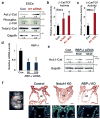Notch post-translationally regulates β-catenin protein in stem and progenitor cells
- PMID: 21841793
- PMCID: PMC3187850
- DOI: 10.1038/ncb2313
Notch post-translationally regulates β-catenin protein in stem and progenitor cells
Abstract
Cellular decisions of self-renewal or differentiation arise from integration and reciprocal titration of numerous regulatory networks. Notch and Wnt/β-catenin signalling often intersect in stem and progenitor cells and regulate each other transcriptionally. The biological outcome of signalling through each pathway often depends on the context and timing as cells progress through stages of differentiation. Here, we show that membrane-bound Notch physically associates with unphosphorylated (active) β-catenin in stem and colon cancer cells and negatively regulates post-translational accumulation of active β-catenin protein. Notch-dependent regulation of β-catenin protein did not require ligand-dependent membrane cleavage of Notch or the glycogen synthase kinase-3β-dependent activity of the β-catenin destruction complex. It did, however, require the endocytic adaptor protein Numb and lysosomal activity. This study reveals a previously unrecognized function of Notch in negatively titrating active β-catenin protein levels in stem and progenitor cells.
Conflict of interest statement
Figures





References
-
- Logan CY, Nusse R. The Wnt signaling pathway in development and disease. Annu Rev Cell Dev Biol. 2004;20:781–810. - PubMed
-
- Radtke F, Clevers H. Self-renewal and cancer of the gut: two sides of a coin. Science. 2005;307:1904–1909. - PubMed
-
- Hayward P, Kalmar T, Arias AM. Wnt/Notch signalling and information processing during development. Development. 2008;135:411–424. - PubMed
-
- Artavanis-Tsakonas S, Rand MD, Lake RJ. Notch signaling: cell fate control and signal integration in development. Science. 1999;284:770–776. - PubMed
Publication types
MeSH terms
Substances
Grants and funding
LinkOut - more resources
Full Text Sources
Other Literature Sources
Molecular Biology Databases
Miscellaneous

